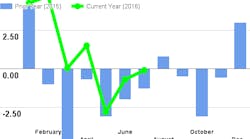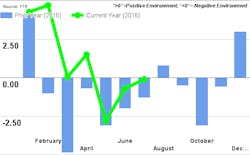FTR’s Shippers Conditions Index (SCI) for July, showing a miniscule improvement from June, remains at a near neutral reading of -0.1, the firm reports.
The index will continue to hover around equilibrium until early 2017 when steady increases in regulatory drag will increase trucking costs due to tightened capacity. The additional regulations queued up affecting the trucking industry could make conditions for shippers much worse toward the end of 2017.
The Shippers Conditions Index is a compilation of factors affecting the shippers transport environment. Any reading below zero indicates a less-than-ideal environment for shippers. Readings below -10 signal conditions for shippers are approaching critical levels, based on available capacity and expected costs. Details of the factors affecting the July Shippers Conditions Index, along with an update from the regulatory front, are found in the September issue of FTR’s Shippers Update published Sept. 6, 2016.
Jonathan Starks, COO at FTR, said: “U.S. shippers have been enjoying a relatively benign transportation market over the last 12 months, as indicated by the near-neutral numbers of the July Shippers Conditions Index. Those conditions will continue for most of 2016 before shifting as we move into 2017. It is a concern that inventory levels continue to remain elevated, but there seems to be little pressure to significantly reduce them in the near-term. Combine that with sluggish manufacturing activity, which has been only partially offset by strength from consumers, and you end up with a freight environment that hasn’t grown strong enough for carriers to remain fully utilized. Without that tight capacity, carriers have been unable to apply upward pressure on pricing. So far, shippers have benefited as a result; however, our expectations of a change in the market for 2017 still remain in place. This will not be an economic change, but rather a regulatory burden on fleets that will reduce capacity and could tighten the marketplace significantly. If that occurs in late 2017 we could see a quick reversal of the price drops that have occurred over the last year.”




